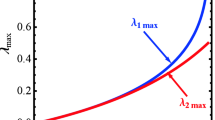Abstract—
The article deals with problems on determining the effective moduli of porous piezoceramic materials with substances that have extreme properties and are deposited on the pore boundaries. The argumentation for the method of effective moduli is given. The reciprocity relation, from which the properties of effective moduli that are similar to known ones for moduli of piezoelectric materials can be obtained, is proved. It is noted that for homogenization of porous piezoelectric composites with rigid or electrode pore boundaries, it is necessary to use models for materials having extremely large moduli that are located on the pore boundaries. Using numerical calculations, anomalous properties of various effective piezoelectric moduli that are promising for practical applications of the investigated piezocomposites have been revealed.
Similar content being viewed by others
REFERENCES
E. Ringgaard, F. Lautzenhiser, L. M. Bierregaard, et al., “Development of porous piezoceramics for medical and sensor applications,” Materials 8 (12), 8877–8889 (2015).
M. Marutake, “A calculation of physical constants of ceramic barium titanate,” J. Phvs. Soc. Jap. 11, 807–814 (1956).
W. Wersing, K. Lubitz, and J. Mohaupt, “Dielectric, elastic and piezoelectric properties of porous PZT ceramics,” Ferroelectrics 68, 77–97 (1986).
A. Bale, R. Rouffaud, A.-C. Hladky-Hennion, et al., “Modeling the electroelastic moduli of porous textured piezoceramics,” IEEE Trans. Ultrason. Ferroelectr. Freq. Control 66 (5), 949–957 (2019).
G. Martinez-Ayuso, M. I. Friswell, S. Adhikari, et al., “Homogenization of porous piezoelectric materials,” Int. J. Solids Struct. 113–114, 218–229 (2017).
G. Martinez-Ayuso, M. I. Friswell, H. H. Khodaparast, et al., “Electric field distribution in porous piezoelectric materials during polarization,” Acta Mater. 173, 332–341 (2019).
A. V. Nasedkin, “Analysis of surface stress influence on the effective properties of nanoporous piezocomposites,” Probl. Prochn. Plast. 81 (1), 5–18 (2019).
L. P. Khoroshun, B. P. Maslov, and P. V. Leshchenko, Predicting Effective Properties of Piezoelectrically Active Composite Materials (Naukova Dumka, Kiev, 1989) [in Russian].
A.V.Nasedkin and M. S. Shevtsova, “Improved finite element approaches for modeling of porous piezocomposite materials with different connectivity,” in Ferroelectrics and Superconductors: Properties and Applications, Ed. by I. A. Parinov (Nova Science Publ., New York, 2011), pp. 231–254.
A. V. Belokon’ and I. I. Vorovich, “Several mathematical problems of the theory of electro-elastic bodies,” in Actual Problems of Mechanics of Deformable Media (DGU, Dnepropetrovsk, 1979), pp. 52–67 [in Russian].
A. V. Belokon’ and I. I. Vorovich, “Initial-boundary value problems in the dynamic theory of electroelasticity,” Izv. SKNTs VSh. Estestv. Nauki, No. 2, 29–32 (1982).
A. N. Rybyanets and A. A. Naumenko, “Nanoparticles transport in ceramic matrixes: a novel approach for ceramic matrix composites fabrication,” J. Mod. Phys. 4 (8), 1041–1049 (2013).
A. Nasedkin, A. Nasedkina, and A. Rybyanets, “Finite element simulation of effective properties of microporous piezoceramic material with metallized pore surfaces,” Ferroelectr. 508, 100–107 (2017).
A. V. Nasedkin, A. A. Nasedkina, and A. N. Rybyanets, “Finite element modeling and analysis of the effective properties of inhomogeneously polarized porous piezoceramic material with partial metallization of pore surfaces,” Diagn. Res. Mech Mater. Struct., No. 5, 38–56 (2018).
B. E. Pobedrya, Mechanics of Composite Materials (Mosk. Gos. Univ., Moscow, 1984) [in Russian].
Funding
This study was supported by a grant from the Government of the Russian Federation no. 075-15-2019-1928.
Author information
Authors and Affiliations
Corresponding author
Additional information
Translated by A. A. Borimova
About this article
Cite this article
Nasedkin, A.V., Nasedkina, A.A. & Nassar, M.E. Homogenization of Porous Piezocomposites with Extreme Properties at Pore Boundaries by Effective Moduli Method. Mech. Solids 55, 827–836 (2020). https://doi.org/10.3103/S0025654420050131
Received:
Revised:
Accepted:
Published:
Issue Date:
DOI: https://doi.org/10.3103/S0025654420050131




